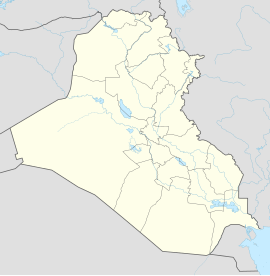Ain Sifni
| Ain Sifni | ||
|---|---|---|
| location | ||
|
|
||
| Coordinates | 36 ° 42 ′ N , 43 ° 21 ′ E | |
| Country |
|
|
| Governorate | Ninawa | |
| Basic data | ||
| height | 500 m | |
| Center of Ain Sifni (Shekhan) | ||
Ain Sifni (also Shekhan or Sheikhan , Arabic عين سفني; Aramaic ܥܝܢ ܣܦܢܐ, kurmandschi Şêxan) is a city in the Iraqi province of Ninawa . It is the capital of the Schechan district and was captured by Kurdish troops in April 2003 . Ain Sifni is mainly inhabited by Yazidis . The religious head of the Yazidis, the Baba Sheikh , lives in Ain Sifni. The place is located in the Nineveh Plain and is one of the disputed areas of Northern Iraq .
history
The original name of the city is Shekhan ( Kurmanji Saxån ). Shekhan literally means “House of the Sheikh” or, in a sense, “Land of the Sheikh” ( Sheikh probably means the Baba Sheikh of the Yazidis who lives there) and is made up of the two words Şêx (German Sheikh) and Xan (German House ) together in Kurmanji . As early as 1850, Sir Austen Henry Layard mentioned the name Ain Sifni as the original name of the place on his travels. In 1975, the city's residents were evicted and forcibly relocated by the Iraqi government. Most of the city's Yazidi population was deported to newly built “model villages” such as Mahad . In return, Arabs and Kurds were settled in Ain Sifni (Shekhan).
See also
Individual evidence
- ↑ German-Turkish Journal: The Yezidis: The "sun worshipers" from Mesopotamia (as of August 2014)
- ↑ Sir Austen Henry Layard: Nineveh and its remains: with an account of a visit to the Chaldæan Christians of Kurdistan, and the Yezidis, or devil worshipers; and an inquiry into the manners and arts of the ancient Assyrians . GP Putnam, 1850 ( google.de [accessed June 14, 2019]).
- ↑ Irene Dulz: The Yezidis in Iraq: between "model village" and escape . LIT Verlag Münster, 2001, ISBN 978-3-8258-5704-2 ( google.de [accessed December 9, 2018]).



